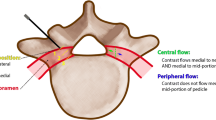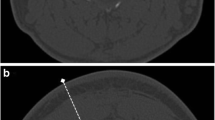Abstract
Objectives
To describe all the CT findings after in situ contrast injection just before steroid injection and to recognize the abnormal aspects associated with intravascular contamination.
Material and methods
We retrospectively evaluated 248 cervical transforaminal steroid injections done at the university hospital in Dijon, France, in 2008–2012, to treat cervicobrachial neuralgia inadequately improved by optimal medical treatment for at least 3 weeks. Features describing the opacification patterns were recorded.
Results
Five main nonvascular opacification patterns were identified: clumps of contrast agent outside the foramen (16 %), a crab claw pattern surrounding the ganglion (13 %), a “French” circumflex accent pattern (15 %), reflux along the needle (7 %), and facet joint capsule opacification (22 %). Concerning the situations requiring a change in needle position, intravenous injection occurred in 26 % of the patients, with a crab claw pattern in half the cases and a clump pattern in half the cases. Intraarteriolar injection was noted in two patients.
Conclusion
CT after in situ contrast injection ensures proper needle positioning outside the blood vessels before steroid injection. Penetration of the needle tip into a vein is very common, whereas arteriolar puncture is extremely rare.















Similar content being viewed by others
References
Radhakhrishnan K, Litchy WJ, O’Fallon WM, Kurland LT. Epidemiology of cervical radiculopathy: a population-based study from Rochester, Minnesota, 1976 through 1990. Brain. 1994;117:325–35.
Bush K, Hillier S. Outcome of cervical radiculopathy treated with periradicular/epidural corticosteroid injections: a prospective study with independent clinical review. Eur Spine J. 1996;5:319–25.
Van Zundert J, Harney D, Joosten EA, Durieux ME, Patijn J, Prins MH, et al. The role of the dorsal root ganglion in cervical radicular pain: diagnosis, pathophysiology, and rationale for treatment. Reg Anesth Pain Med. 2006;31:152–67.
Cyteval C, Thomas E, Decoux E, Sarrabere MP, Cottin A, Blotman F, et al. Cervical radiculopathy: Open study on percutaneous periradicular foraminal steroid infiltration performed under CT control in 30 patients. AJNR. 2004;25:441–5.
Anderberg L, Annertz M, Persson L, Brandt L, Saveland H. Transforaminal steroid injections for the treatment of cervical radiculopathy: a prospective and randomised study. Eur Spine J. 2007;16:321–8.
Rathmell JP, Aprill C, Bogduk N. Cervical transforaminal injection of steroids. Anesthesiology. 2004;100:1595–600.
Drapé JL, Feydy A, Guérini H, Campagna R. Infiltrations articulaires postérieures cervicales en vue d’une épidurale. J Radiol. 2009;90:1414.
Brunner P, Amoretti N, Soares F, Brunner E, Cazaux E, Brocq O, et al. Approaches in injections for radicular pain: the transforaminal, epidural and transfacet approaches. Diagn Interv Imaging. 2012;93:711–22.
Rosenkranz M. Anterior spinal artery syndrome following periradicular cervical nerve root therapy. J Neurol. 2004;251:229–31.
Brouwers PJ, Kottink EJ, Simon MA, et al. A cervical anterior spinal artery syndrome after diagnostic blockade of the right C6-nerve root. Pain. 2001;91:397–9.
Recommandations AFSSAPS Risque de paraplégie/tétraplégie lié aux injections radioguidées de glucocorticoides au rachis lombaire ou cervical Mars 2011. www.afsapps.fr
Pech P, Daniels DL, Williams AL, Haughton VM. The cervical neural foramina: correlation of microtomy and CT anatomy. Radiology. 1985;155:143–6.
Huntoon MA. Anatomy of the cervical intervertebral foramina: vulnerable arteries and ischemic neurologic injuries after transforaminal epidural injections. Pain. 2005;117:104–11.
Demondion X, Lefebvre G, Fisch O, Vandenbussche L, Cepparo J, Balbi V. Radioanatomie des foramens intervertébraux cervicaux et lombaires (vaisseaux, variantes). J Radiol. 2012;93:733–40.
Krausé D, Drapé JL. Spinal infiltration: have you modified your practice? Diagn Interv Imaging. 2013;2014(11):1065–7.
Botwin KP, Gruber RD, Bouchlas CG, Torres-Ramos FM, Freeman TL, Slaten WK. Complications of fluoroscopically guided transforaminal lumbar epidural injections. Arch Phys Med Rehabil. 2000;81:1045–105.
Wybier M. Cervical spinal steroid injections under fluoroscopic guidance (what I am still doing, what I do no longer). Rev Rhum. 2008;75:755–62.
Scanlon GC, Moeller-Bertram T, Romanowsky SM, Wallace MS. Cervical transforaminal epidural steroid injections: more dangerous than we think? Spine Phila Pa 1976). 2007;32:1249–56
Lasbleiz J, Siegfried D, Chales G, Marin F, Sighetti M, Duvauferrier R. Evaluation of CT guided cervical epidural injections in patients with mechanical cervicobrachial neuralgia. J Radiol. 2008;89:317–23.
Lee JY, Nassr A, Ponnappan RK. Epidural hematoma causing paraplegia after a fluroscopically guided cervical nerve root injection. J Bone Joint Surg Am. 2007;89:2037–9.
Stoll A, Sanchez M. Epidural hematoma after epidural block: implications for its use in pain management. Surg Neurol. 2002;57:235–40.
Engel A, King W, Macvicar J. The effectiveness and risks of fluoroscopically guided cervical transforaminal injections of steroids: A systematic review with comprehensive analysis of the published data. Pain Med. 2014;15:386–402.
McLean JP, Sigler JD, Plastaras CT, Garvan CW, Rittenberg JD. The rate of detection of intravascular injection in cervical transforaminal epidural steroid injections with and without digital subtraction angiography. PM R. 2009;1:636–42.
Fitzgerald RT, Bartynski WS, Collins HR. Vertebral artery position in the setting of cervical degenerative disease: implications for selective transforaminal epidural injections. Interv Neuroradiol. 2013;19:425–31.
Jung H, Lim JA, Park KB, Hong SW, Kwak KH, Park JM. Computed tomography-guided cervical selective transforaminal epidural block for an anatomical variations of vertebral artery—a case report. Korean J Anesthesiol. 2013;65:468–72.
Beckworth WJ, Sood R, Katzer AF, Wu B. Anomalous location of the vertebral artery in relation to the neural foramen. Implications in transforaminal epidural steroid injections. Pain Med. 2013;14:119–25.
Jee H, Lee JH, Kim J, Park KD, Lee WY, Park Y. Ultrasound-guided selective nerve root block versus fluoroscopy-guided transforaminal block for the treatment of radicular pain in the lower cervical spine: a randomized, blinded, controlled study. Skeletal Radiol. 2013;42:69–78.
Ludwig MA, Burns SP. Spinal CORD infarction following cervical transforaminal epidural injection: a case report. Spine. 2005;30:266–8.
Author information
Authors and Affiliations
Corresponding author
Rights and permissions
About this article
Cite this article
Pottecher, P., Krausé, D., Di Marco, L. et al. Cervical foraminal steroid injections under CT guidance: retrospective study of in situ contrast aspects in a serial of 248 cases. Skeletal Radiol 44, 1–8 (2015). https://doi.org/10.1007/s00256-014-2028-x
Received:
Revised:
Accepted:
Published:
Issue Date:
DOI: https://doi.org/10.1007/s00256-014-2028-x




